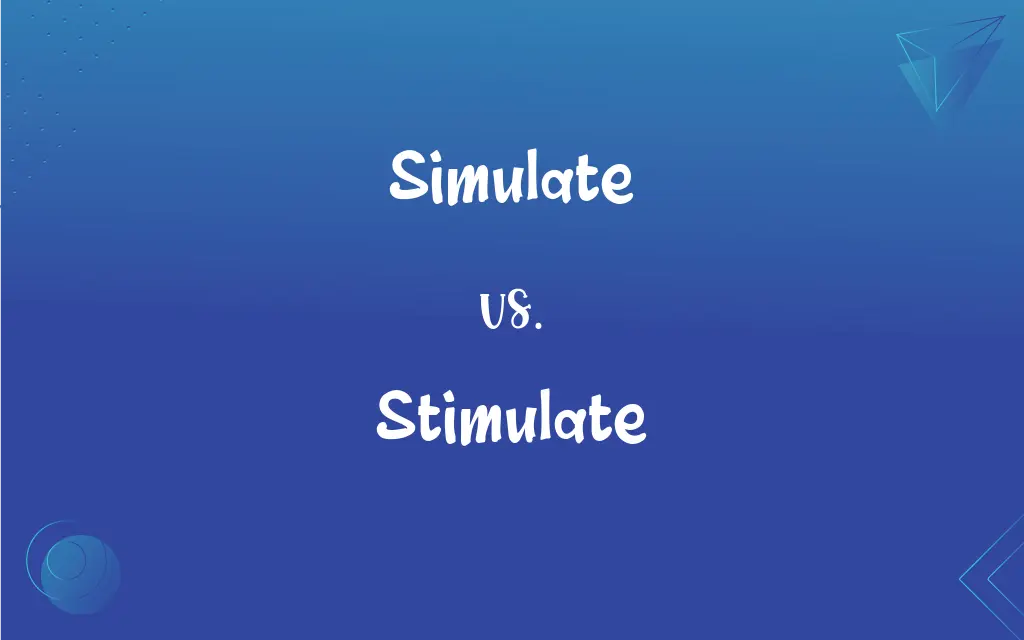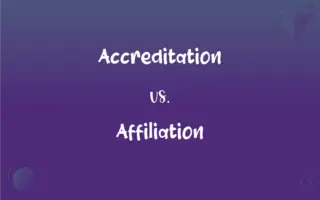Simulate vs. Stimulate: What's the Difference?
Edited by Janet White || By Harlon Moss || Updated on November 15, 2023
Simulate means to imitate or replicate conditions, while stimulate means to encourage or accelerate activity or growth.

Key Differences
Simulate involves creating a likeness or model of a situation, system, or environment, often using computers or other technology. It is a process used to reproduce the conditions of a real-world scenario in a controlled setting, such as pilots training with flight simulators or meteorologists using climate models to replicate weather patterns.
Stimulate refers to the action of applying a catalyst or incentive to prompt or accelerate an activity or response. This can involve exciting a physical, biological, or economic system to induce a desired reaction. For instance, governments may stimulate the economy with fiscal policy, or a cup of coffee might stimulate alertness and concentration.
Simulation is a key tool in education and analysis, providing the ability to explore and experiment without the risks of real-world consequences. Simulated tests are conducted to predict outcomes, such as crash tests in vehicle design, which can save lives by improving safety features before cars reach the market.
Stimulation, on the other hand, is a dynamic process that aims to boost or enhance performance and can be seen in various fields from medicine to economics. For example, electrical nerve stimulation is used therapeutically to relieve pain, and tax breaks can stimulate investment in a particular sector.
While simulation is mainly about representation and study, stimulation is inherently about provoking action. A simulation can help us understand potential future events or the operation of systems, whereas stimulation is geared towards initiating or improving an activity, process, or condition in the present.
ADVERTISEMENT
Comparison Chart
Primary Function
Replicate conditions or behavior
Encourage or accelerate activity
Application
Training, modeling, analysis
Activation, enhancement, growth
Goal
Understanding, safety, prediction
Reaction, improvement, development
Means
Models, technology
Incentives, catalysts
Field Examples
Flight simulation, medical training
Economic policy, physical therapy
ADVERTISEMENT
Simulate and Stimulate Definitions
Simulate
To imitate the appearance or character of.
The actors had to simulate emotions they did not feel.
Stimulate
To encourage activity or growth.
Lower interest rates are meant to stimulate the economy.
Simulate
To create a computer model of something.
The engineers simulate crash tests for car safety.
Stimulate
To invigorate or increase physical sensation.
The spicy food stimulated his taste buds.
Simulate
To use a model to explore behavior.
Scientists simulate the spread of diseases to study pandemics.
Stimulate
To prompt a response or action.
Bright colors can stimulate creativity in children.
Simulate
To pretend or feign.
She simulated ignorance when asked about the surprise party.
Stimulate
To awaken interest or enthusiasm.
The teacher's methods stimulate a love of learning.
Simulate
To reproduce the conditions of a situation.
Emergency drills simulate real-life scenarios for practice.
Stimulate
To accelerate a process or activity.
The new policy is designed to stimulate job creation.
Simulate
To have or take on the appearance, sound, or character of; imitate
Music meant to simulate a snowstorm.
Stimulate
To rouse to action or increased activity; excite
A policy that stimulated people to protest.
Incentives to stimulate consumer spending.
Simulate
To make in imitation of or as a substitute for
Simulate leather.
Stimulate
To increase temporarily the activity of (a body organ or system, for example).
Simulate
To make a pretense of; feign
Simulate interest.
FAQs
What does it mean to simulate an environment?
Simulating an environment means creating a model that mimics the conditions of a particular setting.
How does a stimulus relate to stimulate?
A stimulus is an agent or action that provokes the response intended by the act of stimulation.
Is simulation only used in technology?
No, simulation can be used in various fields, including education, training, and safety drills.
Can art stimulate emotions?
Yes, art can stimulate a wide range of emotions, from joy to sadness.
Can exercise stimulate mental health?
Exercise can stimulate mental health by releasing endorphins that improve mood and reduce stress.
Can simulation be used in medical training?
Yes, simulation is often used in medical training to replicate patient cases and surgical procedures.
What does it mean to stimulate the economy?
To stimulate the economy means to implement measures that promote economic growth and activity.
What's the difference between a simulation and the real thing?
A simulation is an imitation or model, while the real thing is the actual object or event being replicated.
Are simulations accurate?
Simulations can be highly accurate but depend on the quality of the model and input data.
What does it mean to stimulate discussion?
To stimulate discussion means to introduce topics or questions that encourage people to think and contribute ideas.
Is it possible to simulate emotions?
Yes, actors often simulate emotions to portray characters effectively in performances.
What is the purpose of a flight simulator?
The purpose of a flight simulator is to train pilots by replicating the experience of flying an aircraft without any risk.
What role does simulation play in risk assessment?
Simulation plays a crucial role in risk assessment by predicting potential failures and their impacts in a controlled environment.
Can advertisements stimulate consumer demand?
Advertisements can stimulate consumer demand by creating interest and desire for products or services.
How does caffeine stimulate the brain?
Caffeine stimulates the brain by blocking adenosine receptors, leading to increased alertness.
Can music stimulate learning?
Yes, music can stimulate learning by improving mood and concentration, which are conducive to better cognitive function.
How do video games simulate real-life experiences?
Video games simulate real-life experiences through interactive scenarios that mimic real-world actions and consequences.
Are simulated experiences considered deceptive?
Simulated experiences are not necessarily deceptive; they are often openly used as educational or training tools.
Can government policy stimulate innovation?
Government policy can stimulate innovation through grants, tax incentives, and support of research and development.
How can teachers stimulate curiosity in students?
Teachers can stimulate curiosity in students by presenting engaging content, asking provocative questions, and encouraging exploration.
About Author
Written by
Harlon MossHarlon is a seasoned quality moderator and accomplished content writer for Difference Wiki. An alumnus of the prestigious University of California, he earned his degree in Computer Science. Leveraging his academic background, Harlon brings a meticulous and informed perspective to his work, ensuring content accuracy and excellence.
Edited by
Janet WhiteJanet White has been an esteemed writer and blogger for Difference Wiki. Holding a Master's degree in Science and Medical Journalism from the prestigious Boston University, she has consistently demonstrated her expertise and passion for her field. When she's not immersed in her work, Janet relishes her time exercising, delving into a good book, and cherishing moments with friends and family.
































































